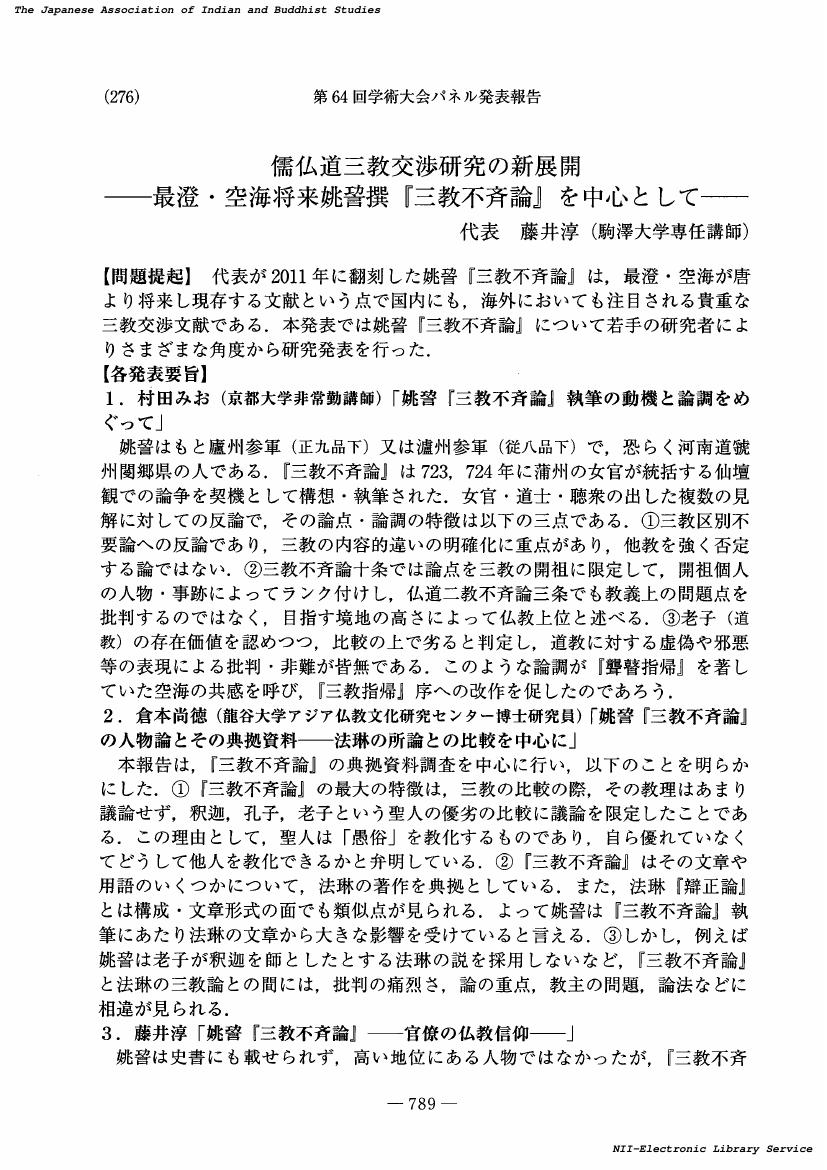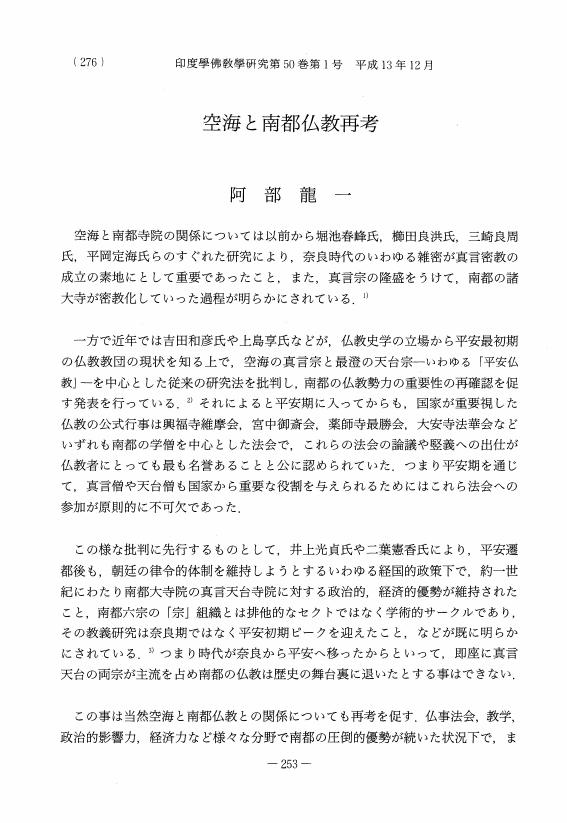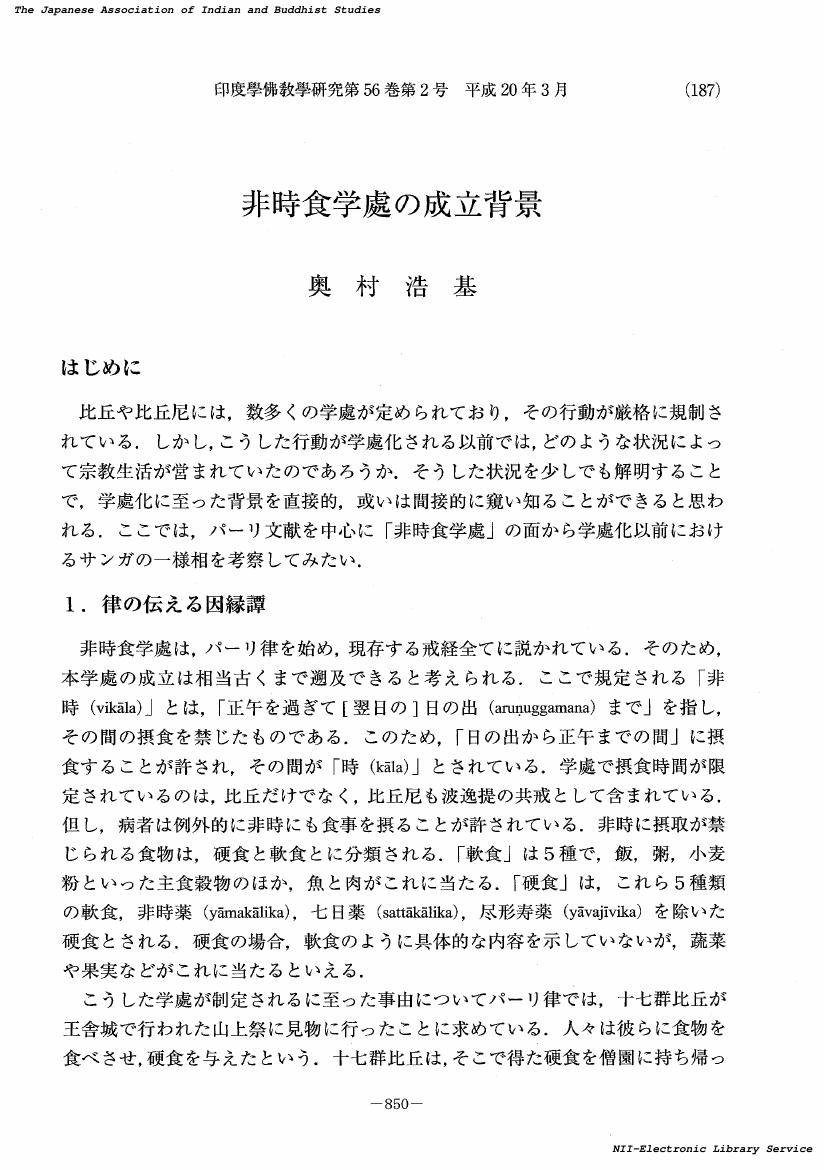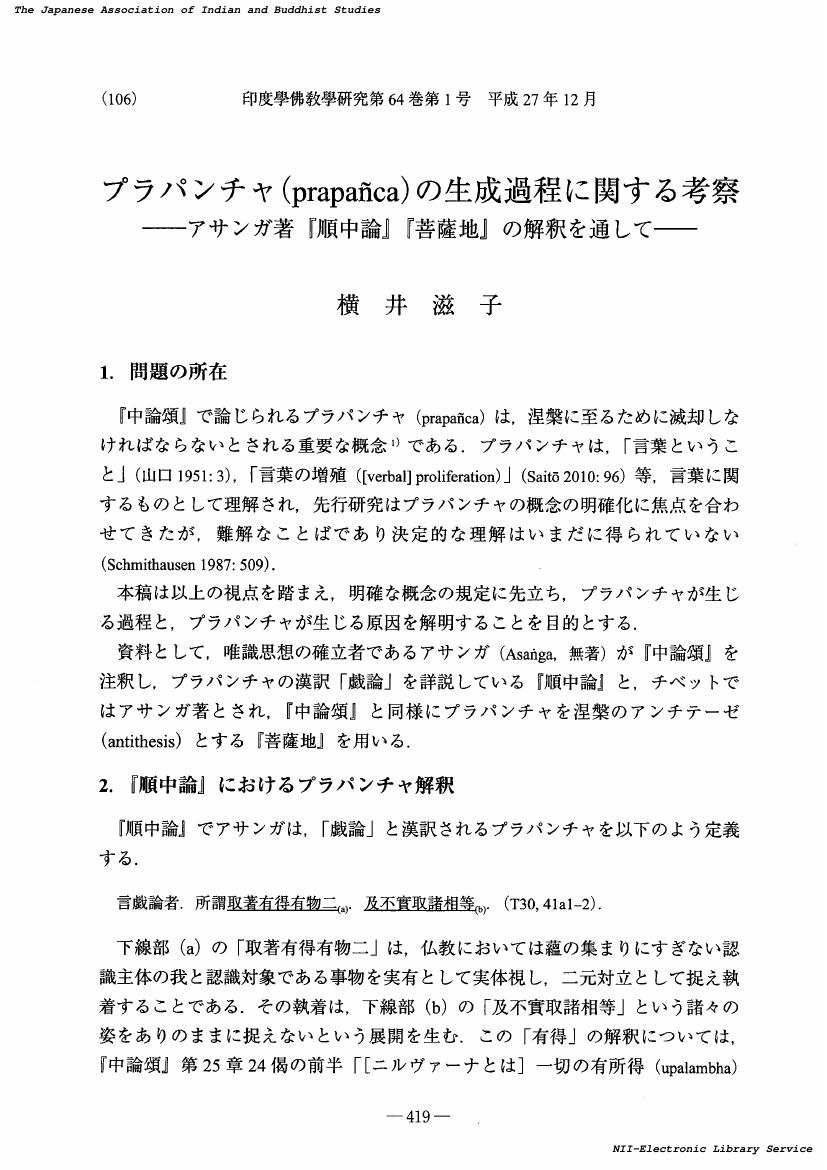- 著者
- Legittimo Elsa
- 出版者
- 日本印度学仏教学会
- 雑誌
- 印度學佛教學研究 (ISSN:00194344)
- 巻号頁・発行日
- vol.56, no.3, pp.1114-1120, 2008
- 被引用文献数
- 1
『法華経』の「見宝塔品」は,壮麗な宝塔が大地より涌出し,空中に住在するという劇的な記述で始まる.この塔は,過去多宝如来の全身舎利を安置しており,多宝如来の往昔の誓願によって出現したものである.釈迦牟尼が白毫より光を放射すると,十方の仏国土に住する如来の分身の姿が映し出される.その時,多宝如來の舎利塔を礼拝するために,十方の諸如来がそれぞれ菩薩を引き連れて,この世界にやって来る.そこで,釈迦牟尼が宝塔を開くと,多宝如来が現れる.多宝如来が自らの座を釈迦牟尼に半分譲ると,空中の宝塔の中で二仏が並座する姿が,衆会の前に顕現する.釈迦牟尼は,ここで『法華経』の功徳を述べ,さらに往昔に一人の聖仙からこの経を授かった因縁を説く.物語は,多宝如来の仏国土から来た智積菩薩の突然の登場,彼と文殊師利との議論へと続く.ここで,龍女成仏の物語が始まる.章の終わりでは三千人が受記を得て,この章が締めくくられる.『菩薩處胎経』には,「見宝塔品」に類似する章題は見られないが,当品の主題,及び記述の詳細が散見される.『處胎経』では,これらの記述は複数の章に分散しているが,『法華経』とパラレルな表現,例えば,宝塔涌出,仏の分身の顕現,他世界から説法を聞きに来る菩薩,二仏並座,受記を授けられる衆会などを見出すことができる.前回の日本印度学仏教学会では,『處胎経』と『維摩経』の比較を通して,『處胎経』における釈迦牟尼中心主義について考察した.今回は,『處胎経』と『法華経』「見宝塔品」のパラレルな記述を比較し,一見『法華経』と同じような記述が,全く別のメッセージを送信していることを分析し,説明していきたい.『處胎経』の著者の第一の目的は,釈迦牟尼への信仰を強化し,他の有名な如来たちからその威光を取り戻すことにあった.このため,著者は意図的にその世界観に合致しない諸経の物語と主題を利用し,変形させたといえる.
1 0 0 0 道元禅師の結界観
- 著者
- 西澤 まゆみ
- 出版者
- 日本印度学仏教学会
- 雑誌
- 印度學佛教學研究 (ISSN:00194344)
- 巻号頁・発行日
- vol.63, no.1, pp.214-217, 2014
- 著者
- Tinsley Elizabeth N.
- 出版者
- 日本印度学仏教学会
- 雑誌
- 印度學佛教學研究 (ISSN:00194344)
- 巻号頁・発行日
- vol.58, no.3, pp.1284-1287, 2010
この論文において,『遍明院大師明神御託宣記』(以下『託宣記』と称す)の制作過程を検討する.同テキストは,建長3年(1251年)にあった託宣の記録として,高野山中院流道範(1184年-1252年)によって記されたと伝えられる.道範は1249年に配所から帰山した.現存する写本には,託宣自体とともに仁治3年(1242年)に起きた金剛峯寺と大伝法院の間の紛争と,仁治4年(1243年)にあった道範を含めて金剛峯寺僧侶の配流についての叙述の部分もある.『託宣記』が作成された時期は,仁治3年の紛争の時期に近く,事件についての情報源も詳しく,貴重な史料であるにもかかわらず,この事件に関する先行研究では『託宣記』との関係については,ほとんど無視されていた.道範が高野山へ帰山が許されたのは1249年であり,大伝法院の再建を条件とするものであったと史料上に示唆されている.しかしながら,『託宣記』には,大伝法院の再建・僧侶の帰山にたいする記述が見られない.それどころか,配流のすぐ後に著されたテキストのように見える.高野山中院流学侶宥快(1345-1416)の著書(『阿互川草薬中記』(1413頃著)など)によると,この託宣自体は,配流以前に下されたものとして理解されている.この宥快による理解は,従来考えられていた『託宣記』の作成時期,作成背景,構造と著者について再考を提示するものであり,テキストの解釈を見直す必要があると思われる.
1 0 0 0 OA 13世紀高野山の伝道範著『遍明院大師明神御託宣記』の構造と制作過程について
- 著者
- Elizabeth N. TINSLEY
- 出版者
- Japanese Association of Indian and Buddhist Studies
- 雑誌
- 印度學佛教學研究 (ISSN:00194344)
- 巻号頁・発行日
- vol.58, no.3, pp.1284-1287, 2010-03-25 (Released:2017-09-01)
この論文において,『遍明院大師明神御託宣記』(以下『託宣記』と称す)の制作過程を検討する.同テキストは,建長3年(1251年)にあった託宣の記録として,高野山中院流道範(1184年-1252年)によって記されたと伝えられる.道範は1249年に配所から帰山した.現存する写本には,託宣自体とともに仁治3年(1242年)に起きた金剛峯寺と大伝法院の間の紛争と,仁治4年(1243年)にあった道範を含めて金剛峯寺僧侶の配流についての叙述の部分もある.『託宣記』が作成された時期は,仁治3年の紛争の時期に近く,事件についての情報源も詳しく,貴重な史料であるにもかかわらず,この事件に関する先行研究では『託宣記』との関係については,ほとんど無視されていた.道範が高野山へ帰山が許されたのは1249年であり,大伝法院の再建を条件とするものであったと史料上に示唆されている.しかしながら,『託宣記』には,大伝法院の再建・僧侶の帰山にたいする記述が見られない.それどころか,配流のすぐ後に著されたテキストのように見える.高野山中院流学侶宥快(1345-1416)の著書(『阿互川草薬中記』(1413頃著)など)によると,この託宣自体は,配流以前に下されたものとして理解されている.この宥快による理解は,従来考えられていた『託宣記』の作成時期,作成背景,構造と著者について再考を提示するものであり,テキストの解釈を見直す必要があると思われる.
1 0 0 0 重源の浄土五祖像将来について
- 著者
- 香月 乗光
- 出版者
- 日本印度学仏教学会
- 雑誌
- 印度學佛教學研究 (ISSN:00194344)
- 巻号頁・発行日
- vol.18, no.2, pp.540-547, 1970
1 0 0 0 法然と明遍の念仏
- 著者
- 伊藤 茂樹
- 出版者
- 日本印度学仏教学会
- 雑誌
- 印度學佛教學研究 (ISSN:00194344)
- 巻号頁・発行日
- vol.64, no.1, pp.50-55, 2015
1 0 0 0 『秘密曼荼羅十住心論』の第六住心について
- 著者
- Jurkovic Sanja
- 出版者
- 日本印度学仏教学会
- 雑誌
- 印度學佛教學研究 (ISSN:00194344)
- 巻号頁・発行日
- vol.54, no.3, pp.1232-1236, 2006
弘法大師空海の主著である『秘密曼荼羅十住心論』及び『秘蔵宝鑰』は, 真言密教の立場から菩提心の諸相を扱う著作であると解釈しえる. そのような観点から, 空海が構想した心の十種の様相の中で,「他縁大乗住心」という法相の教えにあたる第六住心の意味や功用を考察して行きたい.<br>1.「他縁大乗住心」は,『秘密曼荼羅十住心論』の主な典拠である『大日経』の「住心品」における「無縁乗心」という概念にもとづくのではなく,『大日経疏』に説かれている梵語の"apara"の「無縁」と「他縁」の二つの意味の中の「他縁」の義にもとづいて名づけられている. 第六住心を大乗の定型的な「世俗菩提心」の意義を持つ「他縁乗心」の概念で強調する理由は, 小乗に対して「他」に対する慈悲や菩薩の行願を非常に重要な精神的な展開を表すためと思われる. 十住心の中に第六住心の功用は, 次の段階において, 深甚に空性を悟り, さまざまな方便にもとづく行動ができるように, 堅固な菩薩の基本的な心の功徳を形成することである.<br>2. このような構成において, 空海は, 法相の教えを伝統的な菩薩行の代表者として取り扱い,『成唯識論』や『十地経』等を以て, 三無数劫を経る菩薩行の典型としている. 法相宗の阿頼耶識や三性等という認識論的・存在論的な概念は言及しない. 空海は, 法蔵や澄觀等の中国華厳の諸法師と同じように, 法相の教理は主に現象世界を分類し, 三論等の教理は主に実相として空という第一義諦を説くと理解しているといえよう. そこで, 法相を実践的な側面から解釈し, 最初の大乗法門として第六住心に相当することにしたと思われる.<br>3. 第六住心の箇所において,『菩提心論』にもとづいて三無数劫を経る菩薩の波羅蜜等の修行を批判し,「即身成仏」を標榜する真言理趣の優位性が示される. 具体的に第六住心の「普遍大慈発生三昧」の密意を挙げ, 大乗住心等において初めて, 修行者自身が菩提心の多様な顕現であるという『秘密曼荼羅十住心論』の深意が示されると言える.
1 0 0 0 OA 儒仏道三教交渉研究の新展開(第64回学術大会パネル発表報告)
- 著者
- 藤井 淳
- 出版者
- 日本印度学仏教学会
- 雑誌
- 印度學佛教學研究 (ISSN:00194344)
- 巻号頁・発行日
- vol.62, no.2, pp.789-788, 2014-03-20 (Released:2017-09-05)
1 0 0 0 多寳塔思想の起源
- 著者
- 横超 慧日
- 出版者
- 日本印度学仏教学会
- 雑誌
- 印度學佛教學研究 (ISSN:00194344)
- 巻号頁・発行日
- vol.2, no.1, pp.30-36, 1953
1 0 0 0 OA 空海と南都仏教再考
- 著者
- 阿部 龍一
- 出版者
- Japanese Association of Indian and Buddhist Studies
- 雑誌
- 印度學佛教學研究 (ISSN:00194344)
- 巻号頁・発行日
- vol.50, no.1, pp.253-249, 2001-12-20 (Released:2010-03-09)
1 0 0 0 OA 非時食学處の成立背景
- 著者
- 奥村 浩基
- 出版者
- 日本印度学仏教学会
- 雑誌
- 印度學佛教學研究 (ISSN:00194344)
- 巻号頁・発行日
- vol.56, no.2, pp.850-847, 2008-03-20 (Released:2017-09-01)
1 0 0 0 親鸞と二河白道喩
- 著者
- 石原 斌夫
- 出版者
- 日本印度学仏教学会
- 雑誌
- 印度學佛教學研究 (ISSN:00194344)
- 巻号頁・発行日
- vol.29, no.1, pp.180-182, 1980
1 0 0 0 OA 「英雄の旅」としての仏伝Lalitavistaraの理解
- 著者
- 岡野 潔
- 出版者
- 日本印度学仏教学会
- 雑誌
- 印度學佛教學研究 (ISSN:00194344)
- 巻号頁・発行日
- vol.65, no.1, pp.311-303, 2016-12-20 (Released:2017-10-17)
- 参考文献数
- 2
I compared the contents of the Lalitavistara with 24 functions of Morphology of the Folktale (1927) by Vladimir Propp, 17 stages of the Hero’s Journey by Joseph Campbell (The Hero with a Thousand Faces, 1949), and 12 stages of Christopher Vogler’s The Writer’s Journey (2007).
1 0 0 0 OA 翻刻された近世寺院日鑑の活用方法について
- 著者
- 古賀 克彦
- 出版者
- Japanese Association of Indian and Buddhist Studies
- 雑誌
- 印度學佛教學研究 (ISSN:00194344)
- 巻号頁・発行日
- vol.55, no.2, pp.761-767,1260, 2007-03-20 (Released:2010-07-01)
In recent years, there has been extensive publication of reprints of historical records pertaining to Modern-Period temples. They are published in various forms, such as as supplementary materials for the official history of local communities and reports of the study of old manuscripts carried out by groups of citizens and scholars. This paper proposes an investigation of how to utilize these book-format historical materials with such titles as ‘daily record’ and ‘diary.’ As is well known, previous studies have limited their scope either to one Buddhist sect or one temple. And although the shortcomings of such a practice have been pointed out, there do not seem to be any deviations from this practice. It should be made clear that these materials contain not only the records of annual events and private life but also those of an official nature pertaining to the Government, Imperial Court and Head Temple. As such, it is proposed that they may be used to provide a synchronic record of Modern Period Japanese history.
1 0 0 0 OA 慈恩大師基の伝記の再検討
- 著者
- 林 香奈
- 出版者
- 日本印度学仏教学会
- 雑誌
- 印度學佛教學研究 (ISSN:00194344)
- 巻号頁・発行日
- vol.59, no.1, pp.242-246, 2010-12-20
1 0 0 0 OA プラパンチャ(prapanca)の生成過程に関する考察
- 著者
- 横井 滋子
- 出版者
- 日本印度学仏教学会
- 雑誌
- 印度學佛教學研究 (ISSN:00194344)
- 巻号頁・発行日
- vol.64, no.1, pp.419-416, 2015-12-20 (Released:2017-09-01)
1 0 0 0 OA 『法城を護る人々』再検 -近代仏教文学の原点を求めて-
- 著者
- 見理 文周
- 出版者
- Japanese Association of Indian and Buddhist Studies
- 雑誌
- 印度學佛教學研究 (ISSN:00194344)
- 巻号頁・発行日
- vol.23, no.1, pp.194-198, 1974-12-25 (Released:2010-03-09)
1 0 0 0 OA 椎尾弁匡師と共生思想
- 著者
- 神谷 正義
- 出版者
- Japanese Association of Indian and Buddhist Studies
- 雑誌
- 印度學佛教學研究 (ISSN:00194344)
- 巻号頁・発行日
- vol.49, no.1, pp.269-273, 2000-12-20 (Released:2010-03-09)
1 0 0 0 OA 『中論』における無自性をめぐる五種の探求 (pañcadha mrgyamana)
- 著者
- 小澤 千晶
- 出版者
- Japanese Association of Indian and Buddhist Studies
- 雑誌
- 印度學佛教學研究 (ISSN:00194344)
- 巻号頁・発行日
- vol.54, no.2, pp.988-985,1337, 2006-03-20 (Released:2010-03-09)
The purpose of the Mulamadhyamakakarika is to declare nihsvabhavata. For this purpose, Nagarjuna reveals the opponents' contradictions throughvarious means, and proves nihsvabhavata. There are “five types of quest” in his argument. The “five types of quest” adds a denial of difference to the argumentation against wrong views found in Early Buddhism, and leads to the establishment of nihsvabhavata. This paper will show how the way of the argument developed to the “five types of quest” from Early Buddhism's formulation.
1 0 0 0 OA 有形象認識論の形象は非真実か?
- 著者
- 片岡 啓
- 出版者
- 日本印度学仏教学会
- 雑誌
- 印度學佛教學研究 (ISSN:00194344)
- 巻号頁・発行日
- vol.67, no.1, pp.374-367, 2018-12-20 (Released:2019-09-07)
- 参考文献数
- 10
When describing the sākārajñānavādipakṣa, i.e., the thesis of those who hold that cognition is endowed with images, Kamalaśīla explicitly states that manifold images (ākāra) are unreal (asatya) and not absolutely true (pāramārthika). His statement can be interpreted as a negation of the theory of citrādvaita common to the Sautrāntikas and the Yogācāras from the higher perspective peculiar to the Yogācāras, particularly in relation to the asallakṣanānupraveśopāya in which grāhya is denied. In other words, this statement should not be taken as an expression of the alīkākāravāda, i.e., the view that images are false. Therefore, we do not have to abandon our common presumption that the sākārajñānavāda is equivalent to what is later called satyākāravāda. Kamalaśīla’s statement is acceptable in the well-established framing of our theoretical understanding. The value of asatya can vary according to whether the contrast is between parikalpita and paratantra, or between paratantra and pariniṣpanna. The issue that Funayama 2007 raised can be solved in this way. Otherwise, we would have to completely give up our common understanding, because what Kamalaśīla calls sākārajñānavāda would correspond to the alīkākāravāda.







